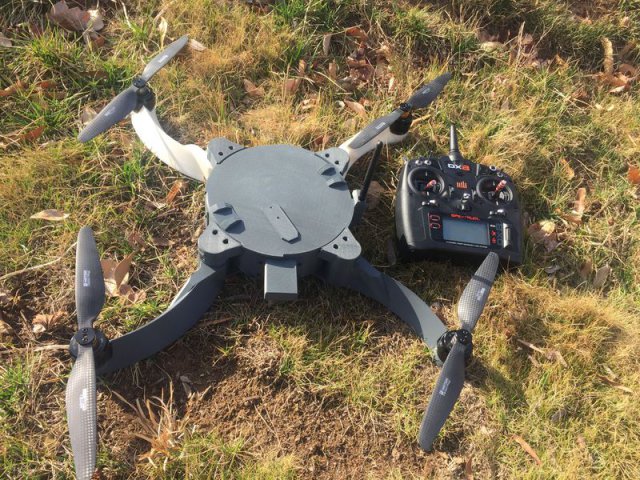
On the battlefield, U.S. Marines have long had a reputation for resourcefulness, a talent for adapting quickly and decisively to the unexpected. So try to imagine a future where Marines, using a laptop and a 3-D printer, are able to build and deploy a drone customized to support that day’s mission.
Sounds far-fetched? Not at all, insists Capt. Christopher Wood, who sees the scenario as more goal than fantasy.
“I don’t want to say that we will achieve that, but that’s where we think we can go,” he said. “We think the technology is there to do something like that, to put drones on the battlefield—on demand, as needed, and with mission-optimized platforms.”
Stretching the range of what’s possible within a military hierarchy has been something a personal mission for Wood, particularly since he was asked to head up a new Marine Corps office, called Next Generation Logistics (NexLog), in the fall of 2015. It was a tiny operation—initially he was the only full-time staffer—but one with an ambitious objective that included getting a better sense of what marines would need to fight in a conflict 10 years from now.
It became clear from the feedback Wood received that a top priority of combat marines was to be able to move faster and have a smaller footprint. That would require a different, more agile, approach to logistics, one that took better advantage of technology emerging outside the realm of conventional defense contractors.
NexLog also had another agenda, Wood said. Could it, even in a small way, begin to cultivate a more innovative culture in the Marine Corps?
“You’re not trying to upend the institution,” he said. “But you are trying to achieve some level of cultural change in a way that’s sustainable and repeatable, so that other folks can begin to mirror that behavior. So, it’s not just our small office trying to be innovative. It’s trying to foster an environment and show a path for others to replicate.”
The centerpiece of that effort is a program called Marine Makers. It’s modelled after the “maker movement,” the DIY-driven subculture that has embraced technologies such as 3-D printing and robotics to make stuff.
To date, NexLog has set up “maker labs” at three military facilities, and also has a mobile lab that moves from base to base, providing training to young marines in soldering, 3-D printing, using sensors, and other skills geared to building low-cost devices.
Recently, Sgt. Jonathan Gillis, another marine committed to spreading the maker message, led a training session at Camp LeJeune in North Carolina. There, he helped a group of marines learn to build drones on their own. But the experience went well beyond a how-to lesson.
“They started out with no knowledge of UAS [Unmanned Aircraft Systems] whatsoever,” said Gillis, who is participating in Military Invention Day at the Smithsonian National Museum of American History on Saturday. “But at the end of a few days, they were starting to think about how the enemy would think about the technology.
“To watch marines at a small unit level think about the implications of technology in their tactics is really interesting,” he added. “It opened up conversations that had implications beyond drones. They would talk about, ‘What if we could work like we have the past few days all the time?’“
Capt. Wood knows how important it is these days for combat marines to understand the role of technology in tactics. He points out that terrorist groups like ISIS make use of digital services such as Google Hangouts.
“We’re fighting adversaries that can be more agile at the low end,” he said. “In many instances, Google Hangouts can outperform some of the command and control platforms we have. We have a huge number of security restrictions on our ability to video-call anyone. But someone in ISIS can just hop on a laptop and hook up to wi-fi and start talking to their commander.
“They can do that in just a few minutes for a few hundred dollars,” he added. “For me to do that kind of thing takes a very expensive communications setup and many layers of security. It’s much more complicated for us. To be able to keep up with them requires us to think a little differently about how we use technology.”
Which brings us back to the notion of drones being built in the field. Wood explained that a trailer with basic equipment, including a 3-D printer, could be located in a forward combat position, and it could be used to create a drone specifically geared to a marine’s mission.
“Maybe it’s a cold-weather, high-altitude mission or maybe it’s an urban mission and you’re rolling through city blocks, and you need drone support for several hours,” Wood noted. “We think a marine will be able to take their mission requirements, translate them into an artificial intelligence-enabled tool, and it will come back with the best UAS that can be designed on the spot. Or, it would at least be able to pull a design out of a catalogue of 50 different platforms. You end up with a drone that’s optimized for you, rather than one system that has to work for a thousand different missions.”
That’s still years away, but Wood is encouraged by how quickly Marine Makers has grown from its grassroots beginnings. About 30 U.S. Marines units now have “making-capability,” he said, with access to a 3-D printer or scanner. They have their own website, too, where they share ideas and projects they’ve done.
“We found the best way is to have them get very hands-on and focused,” he said. “The feedback has been outstanding. It makes them think differently about how they can create change in the world around them.”
Photo: A low-cost drone built by marines – Sgt. Jonathan Gillis
Source: Smithsonian
